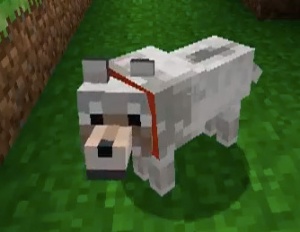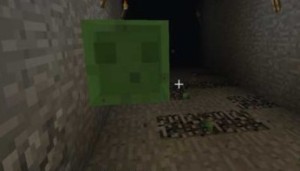(an excerpt from How You Play the Game):
 I have killed three dogs in Minecraft. The way to get a dog is to find a wolf, and then feed bones to the wolf until red Valentine’s hearts blossom forth from the wolf, and then it is your dog. It will do its best to follow you wherever you go, and (like a real dog) it will invariably get in your way when you are trying to build something. Apart from that, they are just fun to have around, and they will even help you fight monsters. If they become too much of a nuisance, you can click on them and they will sit and wait patiently forever until you click on them again.
I have killed three dogs in Minecraft. The way to get a dog is to find a wolf, and then feed bones to the wolf until red Valentine’s hearts blossom forth from the wolf, and then it is your dog. It will do its best to follow you wherever you go, and (like a real dog) it will invariably get in your way when you are trying to build something. Apart from that, they are just fun to have around, and they will even help you fight monsters. If they become too much of a nuisance, you can click on them and they will sit and wait patiently forever until you click on them again.
I drowned my first two dogs. The first time, I was building a bridge over a lake, but a bridge that left no space between it and the water. The dog did its best to follow me around, but it soon found itself trapped beneath the water’s surface by my bridge. Not being smart enough to swim out from under the bridge, it let out a single plaintive yelp before dying and sinking. Exactly the same thing happened to my second dog, as it was this second episode that made this particular feature of dogs clear to me. I know now to make dogs sit if I’m building bridges. I’m not sure what happened to the third dog, but I think it fell into some lava. There was, again, the single yelp, followed by a sizzle. No more dog.
I felt bad each time, while of course fully realizing that only virtual entities were being killed. Surely some of the sorrow I felt was imported from the real world, where I am fond of dogs and do what I can to avoid drowning or burning them. I could not be said to have developed a meaningful relationship with my virtual dogs, but I was pleased to see them each time they caught up with me, and I was a little sad to realize they wouldn’t be getting in my way anymore. I think I was right to feel at least a little bit bad about killing them. But how can there be any place for emotional or even moral attachments to virtual characters? What could cause me to feel any kind of sympathy or concern for beings that don’t really exist?
The answer probably has something to do with the way humans are wired to form attachments to other beings generally. From the perspective of evolution, it’s obviously good that we form strong attachments to human infants. It’s also good that our ancestors formed strong attachments to pets, and not merely because pets can be trained to help us. Pets also share their germs with us, and those ancient people whose constitutions allowed them to survive their pets’ germs bestowed upon us, their descendants, stronger immune systems. So over time we have come to be wired to love furry little things. This general disposition to like animals probably spills over into our encounters with virtual animals – and so we come to feel attachments to them too.
But to explain our attachments to virtual animals in this way does not necessarily lessen those attachments. After all, similar explanations explain why we like babies and dogs – and even cats – and typically we take those felt obligations very seriously. So unless we have some very good reason to overrule the concerns we naturally feel for virtual animals, we should take those obligations seriously as well. But here is a very good reason to overrule these concerns we feel: unlike real dogs and cats, virtual dogs and cats don’t actually feel anything. They are not any more real than the dogs and cats in dreams or comic books. So while we might naturally feel some attachment to them, we do not have any real obligations to them. Thinking that we do have obligations would be like thinking we should worry about how Snoopy feels if we stop reading Peanuts. There isn’t any real being there to be an object for our concern.
***
We humans form attachments with the unlikeliest of objects. Anyone who doubts this might consider how they would feel if they were asked to throw away their teddy bear. It is just an object, of course, with no feelings or thoughts whatsoever. No real harm is done to anyone by holding it under water or tossing it into a pool of lava. Yet we would not do such things lightly, since we have formed attachments to our teddy bears. We have been through a lot with them – scary nights and lonely times – and having them in our arms has helped us to feel better. We end up feeling that we owe them something, out of gratitude and respect. When it comes time to part, we might consider passing them along to other children, so long as we can assure ourselves that the teddy bears are going to good homes. At one level this is all silly, of course. But that level is not nearly as important to us as the level on which it is not silly at all.
When it comes time to tear down the old school, we feel concern for the bricks and mortar. We never regard them as sentient, but we think of the role the building has had in our lives – perhaps we have passed through the halls, and so have our children. We have grown up there, and we cherish it. It is, we say, of “sentimental value”, but too often that label is preceded with the qualifier “merely”. There is nothing “mere” about such value. None of us would want to see sentimental value deprived of all significance, even if we realize that sometimes it is necessary to let go. At these moments, we register a loss, and the loss often seems to us immeasurable in the terms of any other calculus.
 There is no reason not to form attachments to virtual places and characters as well, though this kind of object is relatively new to the scene, and typically these virtual objects aren’t around for very long even in the best of cases. Consider the story of Jerry the slime. A prominent Minecraft player (“CaptainSparklez”) found himself being followed around by a baby slime with a cute smile. He hesitated to kill it, and decided instead to build it a pen and name it “Jerry”. Jerry eventually de-spawned, as that is the fate of such creatures. CaptainSparklez and his followers were sufficiently distraught to build an enormous tree as a monument to Jerry. Now, to be sure, this whole episode was motivated in large part by the joy of pure silliness, and by players just wanting to have some fun with the idea of memorializing a slime. But, undeniably, there was a primitive attachment that served as a basis for the fun. It is not unthinkable for someone to feel that sort of attachment to a virtual slime – indeed, its possibility is what makes the joke possible in the first place. And even now I can hear CaptainSparklez protest in mock seriousness, “How dare you make fun of Jerry!” But the seriousness is not entirely mocking. (For whatever it’s worth, we may also note that Jerry has his own fans who have created special Jerry mods and a special Jerry game. He has his own Facebook page. Jerry has more friends than I do.)
There is no reason not to form attachments to virtual places and characters as well, though this kind of object is relatively new to the scene, and typically these virtual objects aren’t around for very long even in the best of cases. Consider the story of Jerry the slime. A prominent Minecraft player (“CaptainSparklez”) found himself being followed around by a baby slime with a cute smile. He hesitated to kill it, and decided instead to build it a pen and name it “Jerry”. Jerry eventually de-spawned, as that is the fate of such creatures. CaptainSparklez and his followers were sufficiently distraught to build an enormous tree as a monument to Jerry. Now, to be sure, this whole episode was motivated in large part by the joy of pure silliness, and by players just wanting to have some fun with the idea of memorializing a slime. But, undeniably, there was a primitive attachment that served as a basis for the fun. It is not unthinkable for someone to feel that sort of attachment to a virtual slime – indeed, its possibility is what makes the joke possible in the first place. And even now I can hear CaptainSparklez protest in mock seriousness, “How dare you make fun of Jerry!” But the seriousness is not entirely mocking. (For whatever it’s worth, we may also note that Jerry has his own fans who have created special Jerry mods and a special Jerry game. He has his own Facebook page. Jerry has more friends than I do.)
The point is that we form attachments to things that may have no feelings or rights whatsoever, but by forming attachments to them, they gain some moral standing. If you really care about something, then I have at least some initial reason to be mindful of your concern. (Yes, lots of complications can come in here – “What if I really care for the fire that is now engulfing your home?” – but the basic point stands: there is some initial reason, though not necessarily a final or decisive one.) I had some attachment to my Minecraft dogs, which is why I felt sorry when they died. Had you come along in a multiplayer setting and chopped them to death for the sheer malicious pleasure of doing so, I could rightly claim that you did something wrong.
Moreover, we can also speak of attachments – even to virtual objects – that we should form, just as part of being good people. Imagine if I were to gain a Minecraft dog that accompanied me on many adventures. I even offer it rotten zombie flesh to eat on several occasions. But then one day I tire of it and chop it into nonexistence. I think most of would be surprised: “Why did you do that? You had it a long time, and even took care of it. Didn’t you feel attached to it?” Suppose I say, “No, no attachment at all”. “Well, you should have”, we would mumble. It just doesn’t seem right not to have felt some attachment, even if it was overcome by some other concern. “Yes, I was attached to it, but it was getting in the way too much”, would have been at least more acceptable as a reply. (“Still, you didn’t have to kill it. You could have just clicked on it to sit forever….”)
Leave a comment